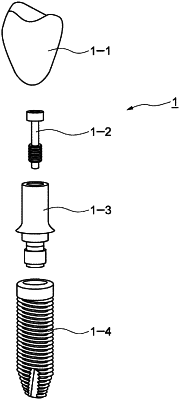| CPC A61C 8/0013 (2013.01) [A61C 8/00 (2013.01); A61K 6/838 (2020.01); A61L 27/12 (2013.01); A61L 27/40 (2013.01); A61C 8/005 (2013.01); A61C 13/09 (2013.01)] | 9 Claims |

|
1. A method of treating a patient with at least one defect in at least one tooth, or in tissues associated with teeth, or both, comprising:
embedding an artificial dental root in a bone in an oral cavity,
the artificial dental root is attached to a dental prosthesis,
the dental prosthesis comprises hydroxyapatite fine particles on a surface of the dental prosthesis,
the hydroxyapatite fine particles are sintered bodies,
the hydroxyapatite fine particles have a mean particle size of 10 to 1,000 nm,
the hydroxyapatite fine particles are attached to the dental prosthesis via covalent bonding,
the covalent bonding is formed by reacting a reactive group of the dental prosthesis, a reactive group of hydroxyapatite fine particles, and two or more reactive groups of a linker compound,
a surface coverage of the hydroxyapatite fine particles is 15 to 60%, and
the amount of calcium carbonate in the hydroxyapatite fine particles is equal to or lower than 0.1/99.9 of formula weight,
wherein the surface coverage is an area ratio of a portion corresponding to the hydroxyapatite fine particles to a portion corresponding to a substrate of the prosthesis,
wherein a weight loss of 2% or more with endothermic change is not observed in a range of 650° C. to 800° C. when measured with thermal gravimetric-differential thermal analysis, and
wherein an absorbance plot calculated by the Kubelka-Munk equation from a spectrum obtained in a FT-IR measurement does not show a peak near 877 cm−1 when the peaks appearing in wavenumbers of 860 cm−1 to 890 cm−1 are separated.
|